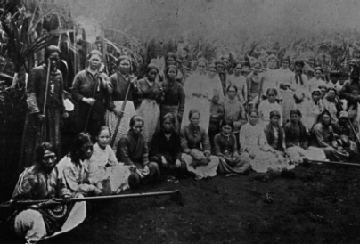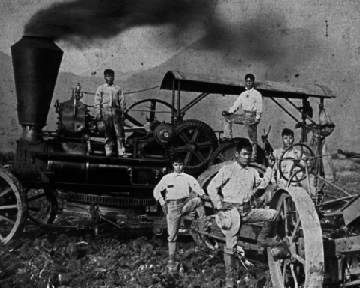 One outcome of Kalakaua’s visit to Japan in 1881 was an agreement between the Hawaiian and Japanese governments in 1885 to allow Japanese immigrant laborers to travel to Hawai’i for plantation work. Although an earlier group of Japanese immigrant workers had arrived in 1868, for 17 years thereafter, the Meiji government prohibited emigration of workers due to reports that workers were treated harshly. For nine years after the 1885 agreement, twenty-nine Japanese government-sponsored groups were sent to Hawai’i before the agreement was terminated in 1894. However, private labor contractors continued to bring Japanese workers to Hawaii’i until 1924, when immigration from Japan was banned by the U.S. government, which controlled Hawai’i as a Territory. The ban was based on fears that the increasing Japanese population in Hawai’i and on the West Coast of America would threaten American political control.
One outcome of Kalakaua’s visit to Japan in 1881 was an agreement between the Hawaiian and Japanese governments in 1885 to allow Japanese immigrant laborers to travel to Hawai’i for plantation work. Although an earlier group of Japanese immigrant workers had arrived in 1868, for 17 years thereafter, the Meiji government prohibited emigration of workers due to reports that workers were treated harshly. For nine years after the 1885 agreement, twenty-nine Japanese government-sponsored groups were sent to Hawai’i before the agreement was terminated in 1894. However, private labor contractors continued to bring Japanese workers to Hawaii’i until 1924, when immigration from Japan was banned by the U.S. government, which controlled Hawai’i as a Territory. The ban was based on fears that the increasing Japanese population in Hawai’i and on the West Coast of America would threaten American political control.
 Despite the long hours, the low pay, the hard work, and the harsh conditions of plantation life, many of the Issei stayed on in Hawai'i rather than return to Japan. They began to raise families. (Bachelor workers sent for brides from their homeland; others brought their wives with them.) Both men and women worked on plantations, contributing to the great wealth produced by the sugar industry. "By the 1930s, Japanese immigrants, their children, and grandchildren had set down deep roots in Hawaii" (See “Hawaii: Life in a Plantation Society,” at the Library of Congress website.)
Despite the long hours, the low pay, the hard work, and the harsh conditions of plantation life, many of the Issei stayed on in Hawai'i rather than return to Japan. They began to raise families. (Bachelor workers sent for brides from their homeland; others brought their wives with them.) Both men and women worked on plantations, contributing to the great wealth produced by the sugar industry. "By the 1930s, Japanese immigrants, their children, and grandchildren had set down deep roots in Hawaii" (See “Hawaii: Life in a Plantation Society,” at the Library of Congress website.)
The Nisei (second generation of Japanese abroad) grew up in a bicultural environment; they were taught to respect their ancestors and ancestral culture and attended Japanese language schools and Buddhist temples; at the same time, they were U.S. citizens educated in American schools. When the war between Japan and America broke out in 1941, many Nisei volunteered for U.S. military service and distinguished themselves for bravery and loyalty to America. (See the Go For Broke National Education Center for information about the service of Nisei soldiers in the100th Infantry Battalion, the 442nd Regimental Combat Team, and the Military Intelligence Service.)
Before, during and after the war, the Issei and their descendents moved from the plantation and into the economy of the multiethnic society that was developing in the islands. They worked with and among other ethnic groups, including Hawaiians, Whites, Chinese, Puerto Ricans, Filipinos, and Koreans to contribute to the political, economic, social, and cultural life of a multicultural community. In Recollections (1993), Hawaiian writer John Dominis Holt captures the rich, vibrant world of multicultural Honolulu in the first half of the twentieth century:
As I recall Hawai'i before statehood, computers, and nuclear warheads, it was a world of great eating and drinking bouts, flavored by the introduction of customs and habits of the diverse peoples who came to settle in Hawai'i. The exotic foods of Asia, Europe, and America and the salty, fatty cuisine that became labeled as Hawaiian were eaten by all. The old fish market downtown flourished with foods of all kinds and became a sort of esplanade, a gathering place, for both fashionable and ordinary people alike. Everyone went to market, not only to shop, but to meet friends.
The Chinese gave great dinners of stuffed oysters, shrimp Cantonese, egg rolls, broiled squab, hum hah pork, lop cheong, sweet-sour cabbage and meat, kau yuk, and many other delicacies.
The Hawaiians celebrated by giving lu'au, replete with kalua pua'a (pig cooked in an imu, or underground oven), various types of raw fish and limu (seaweed), chicken or squid fixed with taro leaves and coconut milk, and sweet potatoes. The feast was topped off with rich, custard-filled cream cakes and washed down with soda pop of all flavors. The tables were decorated with fern leaves, hibiscus flowers, bananas, papayas, breadfruit, and mangoes.
The Portuguese cooked great pieces of pickled pork. They produced marvelous breads and a tasty doughnut called malasadas for feast days and Holy Ghost celebrations.
The Japanese, at New Year’s, would spend a half-year’s wages on wonderfully decorative and imaginative delicacies. Sweet rice-paste cakes called mochi were filled with a black bean mixture called black sugar. Fish was prepared in the most stylish and incredible ways; a simulated net carved from a great turnip would cover a whole fish. This splendid display would be given a final embellishment of flower-like decorations carved from carrots and radishes.
The Puerto Rican people feasted on cundudis, pigeon peas and rice, and pateles made with mashed green bananas that served the purpose of corn meal in a tamale. They also served deliciously flavored roasted bits of beef or pork.
At wedding celebrations, the Filipino people roasted whole pigs over a spit and prepared a strongly spiced dish made from chicken or pork, called adobo. It was a marvelous sight to come upon a little house in the cane field camps of the sugar plantations and find the golden-crusted carcass of a hog being patiently turned on a spit over hot coals. It was even more rewarding to stay and be offered bits of the barbecued pork, especially the skin, roasted crisp with the consistency of peanut brittle.
Holt also remembers of Japanese flower seller who lived in his neighborhood:
The flower lady, Mrs. Yamashita, lived above us in a well-run, attractive house. A widow, she grew flowers with the help of her sons—pleasant, likeable, young men, who all graduated from the University of Hawai'i. Mrs. Yamashita arrived carrying her basket and wearing a large hat. She grew mainly African daisies, fragrant carnations, and varieties of chrysanthemums. Always, Mummah bought several bunches of African daisies, which sat giddy and delicate, in a cut-glass vase on the dining room table. Carnations went into another cut-glass vase to sit on a pedestal of koa. Chrysanthemums, when we could afford them, went into a squarish Chinese vase and were placed on one of the remaining tall, thin Chinese plant stands. Mrs. Yamashita was all business, telling us only the briefest details of how her sons and one daughter were faring at school.
Hokule'a's navigator, Nainoa Thompson, remembers the learning he received from Yoshio Kawano, the milkman, while growing up in the 1950's in Niu Valley:
Nainoa grew up on his grandfather's dairy and chicken farm in Niu Valley-when the valley was still all country. It was Yoshio Kawano, the milkman, who introduced the ocean to Nainoa. Dawn would often find Nainoa sitting on Yoshi's doorstep, waiting for Yoshi to take him fishing. Yoshi would bundle Nainoa into the old car, and off they'd go to fish in the streams or on the reefs. He came to be at home with the ocean, feeling the wind, the rain, the spray against his body. To the five-year-old Nainoa, the ocean was huge, wild, free, and open. The ocean and the wind were always changing; this was so different from the serenity of the mountains and the farm. Nainoa came to sense and feel the tune of the ocean world, develop-ing a personal relationship with the sea. These early experiences, Nainoa thinks, were an essential preparation for becoming a navigator: "We learn differently when we are young; our understanding is intuitive and unencumbered."
Nainoa learned from Yoshio; he learned from Dad, from Mom, from Grandma and Grandpa; he learned from those who loved him and showed him kindness. Nainoa thrived. (From Recollections of Childhood).
When the Honolulu Advertiser celebrated its 150th birthday in 2006, it published biographies of islanders who have made signficant contributions to island life; among them were those of Japanese ancestry who have led in various areas of society:
Political Figures: Daniel K. Inouye and Spark M. Matsunaga, two WW II veterans who became the first U.S. Senators of Japanese Ancestry; Patsy Takemoto Mink who served in the U.S. House of Representatives from 1964-1977 and from 1990-2002; and George R. Ariyoshi served as the governor of Hawai’I from 1974 to 1986.
Social and Cultural Figures: Koji Ariyoshi fought to better the conditions of the working class; doctor Terry Shintani, artists Isamu Doi and Satoru Abe; and writer Lois Ann Yamanaka,
Sports Figures: Mackay Yanagisawa and Sad Sam Ichinose
The following websites provide more information about the Japanese immigration to Hawai’i and the Japanese in Hawai’i:
- "Plantation life” by Mike Gordon, Honolulu Advertiser, Posted on: Sunday, July 2, 2006
- Hawaii Guide: “The Japanese in Hawai'i” by Dennis Ogawa and Glen Grant
- Japanese American National Musuem: “Brief Historical Overview of Japanese Emigration, 1868-1998” (Japanese immigration to Hawaii in the context of the Japanese government’s immigration strategy)
- Official site of Senator Daniel K. Inouye
- University of Hawai’i Library Archives: Sen. Spark M. Matsunaga Papers
- Biographical Directory of the United States Congress: Patsy Takemoto Mink
- Wikipedia: Biography of George Ariyoshi

 One outcome of Kalakaua’s visit to Japan in 1881 was an agreement between the Hawaiian and Japanese governments in 1885 to allow Japanese immigrant laborers to travel to Hawai’i for plantation work. Although an earlier group of Japanese immigrant workers had arrived in 1868, for 17 years thereafter, the Meiji government prohibited emigration of workers due to reports that workers were treated harshly. For nine years after the 1885 agreement, twenty-nine Japanese government-sponsored groups were sent to Hawai’i before the agreement was terminated in 1894. However, private labor contractors continued to bring Japanese workers to Hawaii’i until 1924, when immigration from Japan was banned by the U.S. government, which controlled Hawai’i as a Territory. The ban was based on fears that the increasing Japanese population in Hawai’i and on the West Coast of America would threaten American political control.
One outcome of Kalakaua’s visit to Japan in 1881 was an agreement between the Hawaiian and Japanese governments in 1885 to allow Japanese immigrant laborers to travel to Hawai’i for plantation work. Although an earlier group of Japanese immigrant workers had arrived in 1868, for 17 years thereafter, the Meiji government prohibited emigration of workers due to reports that workers were treated harshly. For nine years after the 1885 agreement, twenty-nine Japanese government-sponsored groups were sent to Hawai’i before the agreement was terminated in 1894. However, private labor contractors continued to bring Japanese workers to Hawaii’i until 1924, when immigration from Japan was banned by the U.S. government, which controlled Hawai’i as a Territory. The ban was based on fears that the increasing Japanese population in Hawai’i and on the West Coast of America would threaten American political control. Despite the long hours, the low pay, the hard work, and the harsh conditions of
Despite the long hours, the low pay, the hard work, and the harsh conditions of